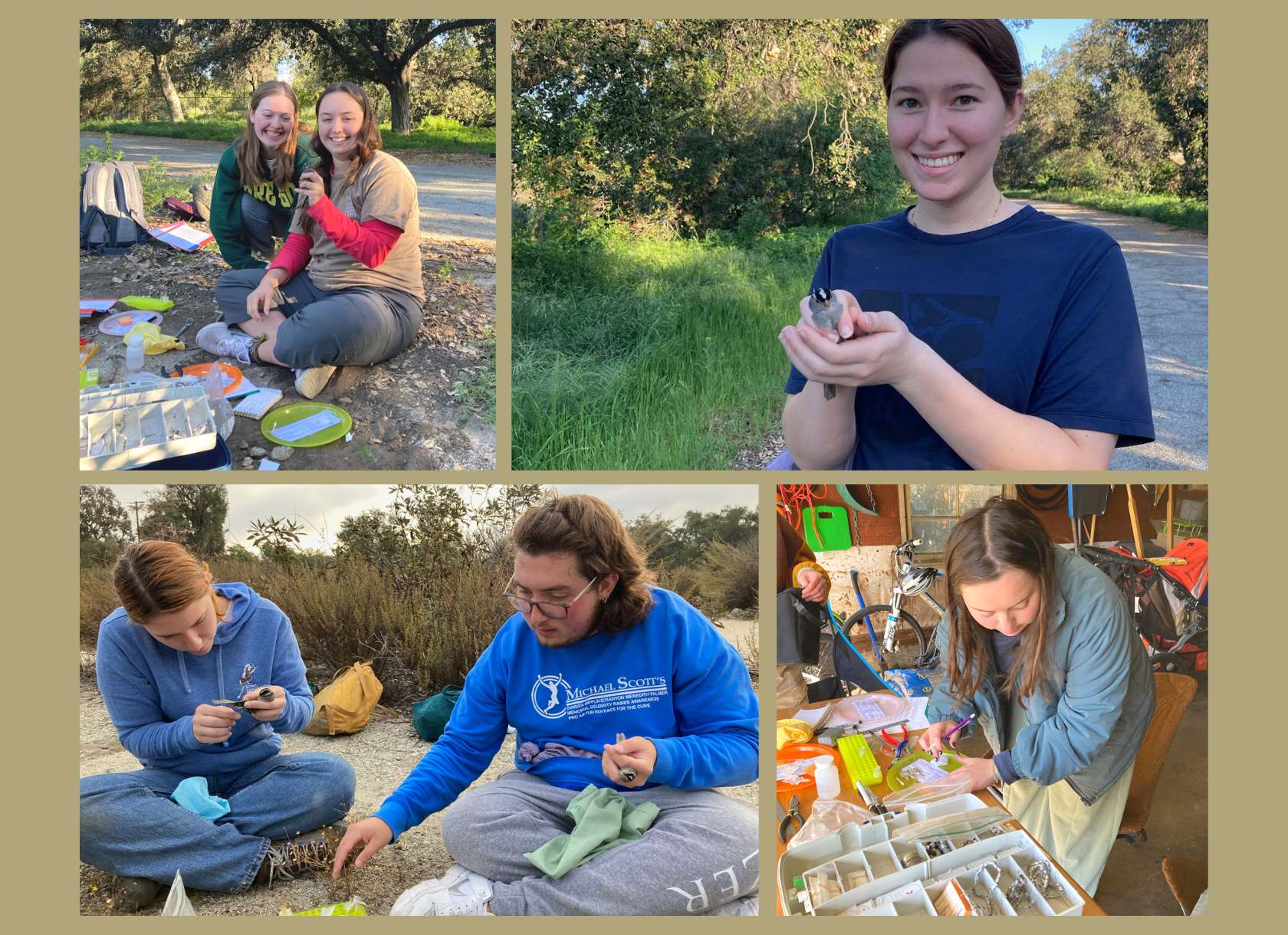By Rachael Warecki ’08

At 6:30 a.m. on a Wednesday morning in February, Claire Molina ’23 and Jessica Bonnen ’23 arrive at the Robert J. Bernard Biological Field Station (BFS), an 86-acre ecological habitat and academic resource located at The Claremont Colleges. Their morning’s goal: to trap, measure, and band the white-crowned sparrows who make their winter homes at the field station. By tracking these birds, taking their measurements, and studying their behaviors, they’ll better understand what factors might be key to their survival as a species.
“We check the birds’ fat by blowing on their chests,” Bonnen laughs. “Obviously, they’re covered in feathers, so blowing on their chests exposes the fat deposits on their chests. It’s a good measure of how they’re doing, in terms of food.”
Molina and Bonnen work under the guidance of Elise Ferree, professorial lecturer in biology at the W.M. Keck Science Department, who’s studying the sparrows and their local habitats through a conservational lens. A 2019 study published in the academic journal Science found that nearly 30 percent of all North American birds have disappeared since 1970.
The causes are manifold—including habitat loss, window strikes, urbanization, outdoor cat predation, and poison from insect-killing plant sprays—and the decline in the North American bird population is indicative of a larger problem on a global scale. Ferree’s research asks: How do winter habitats affect the ongoing survival of migratory birds?
Although white-crowned sparrows are a common species, very little is known about their winter behavior beyond the fact that they migrate to California and Mexico from Alaska; some of them migrate to the BFS. While white-crowned sparrows are not currently in decline, Ferree notes, “we want to preserve them—and all species.”
Over the course of five years, Ferree and her students have found that the sparrows who return to the BFS each year come back to the same small portion of plants, suggesting that the field station plays an important role in migratory avian conservation. The habitats at BFS include alluvial fan scrub, a live oak forest, grassland, and several intact patches of coastal sage scrub, which the sparrows need for protection.
While conducting fieldwork at the BFS for Ferree’s lab, students learn all aspects of handling wild birds, including trapping, measuring, and banding them to recognize the birds who return each winter.
“This is a great opportunity to train students in handling birds,” Ferree says. “Their participation in this research provides them with useful skills for future scientific and conservation careers.”
But the BFS isn’t the only local site where white-crowned sparrows settle in for the winter months. The birds also roost in Claremont-area backyards, leading Ferree to explore how human behavior and human-made natural spaces contribute to—or detract from—the sparrow population’s success during the winter.
This semester, her students are expanding their research beyond the BFS, trapping and studying these birds in the local resident community, including in Ferree’s own backyard. They’re hoping to ascertain whether the sparrows who winter in Claremont form flocks among each other. Ferree is also partnering with Assistant Professor of Biology Sarah Budischak, a disease ecologist, to learn how parasites may influence the sparrows’ behavior. Together, they’re examining the parasites with which the birds arrive and depart, and if these parasites influence the sparrows’ winter success.
Molina says that interacting with the Claremont community is her favorite part of fieldwork. Since her senior thesis revolves around this hands-on research, she’s taken a leadership role in coordinating trapping efforts in neighbors’ backyards.
“During my time in Claremont, this has probably been the most time I’ve spent in the neighborhoods around the Colleges,” she says. “I’ve been able to make such cool contacts.”
Eliza Kornfeld ’23, who’s also working on her senior thesis, is extracting the sparrows’ DNA from blood samples taken at BFS and in the community, then performing PCR and gel electrophoresis tests to determine the birds’ sex using genetic analysis. Because the male and female sparrows look the same, determining each individual bird’s sex helps Ferree’s team better understand the composition of the winter flocks and whether males or females have higher rates of return to the BFS.
“Eventually I want to go to medical school, so learning these laboratory techniques is incredibly valuable,” Kornfeld says. “PCR specifically has transformed diagnostic medicine and scientific research, so I’m thankful I can learn it now as an undergraduate with the guidance of Professor Ferree, who has been an amazing mentor.”
“I really love this lab, because Professor Ferree makes it very easy for a lot of people to participate,” adds Bonnen, who’s hoping to pursue a career studying animal behavior. “It’s nice to get out there in nature with other people who are passionate about the same things I am, and it reaffirms that this is what I love, that I’m here for a reason. It provides such a great hands-on experience.”

